ED228, ED289, ED290, ED291, ED293, ED294: Financial Reporting Updates
VerifiedAdded on 2022/10/04
|5
|1358
|21
Report
AI Summary
This report presents a financial reporting newsletter designed for an accounting firm specializing in preparing general-purpose financial reports for large companies listed on the Australian Securities Exchange (ASX). The newsletter serves to update staff on the latest financial reporting news, alerting them to changes and developments that may impact their work. The report covers several key updates, including Interest Rate Benchmark Reform (ED228), Annual Improvements to Australian Accounting Standards 2018–2020 (ED289), a new Conceptual Framework for Financial Reporting (ED290), New Definitions and Guidance for Non-Profit Entities (ED291), Amendments to Australian Accounting Standards (ED293), and Deferred Tax arising from a single transaction related to Assets and Liabilities (ED294). Additionally, the report includes a memo to the Directors of Snow Gear Ltd. discussing methods for classifying expenses on the statement of profit and loss, outlining the expenses by nature and function approaches, and referencing relevant AASB standards.
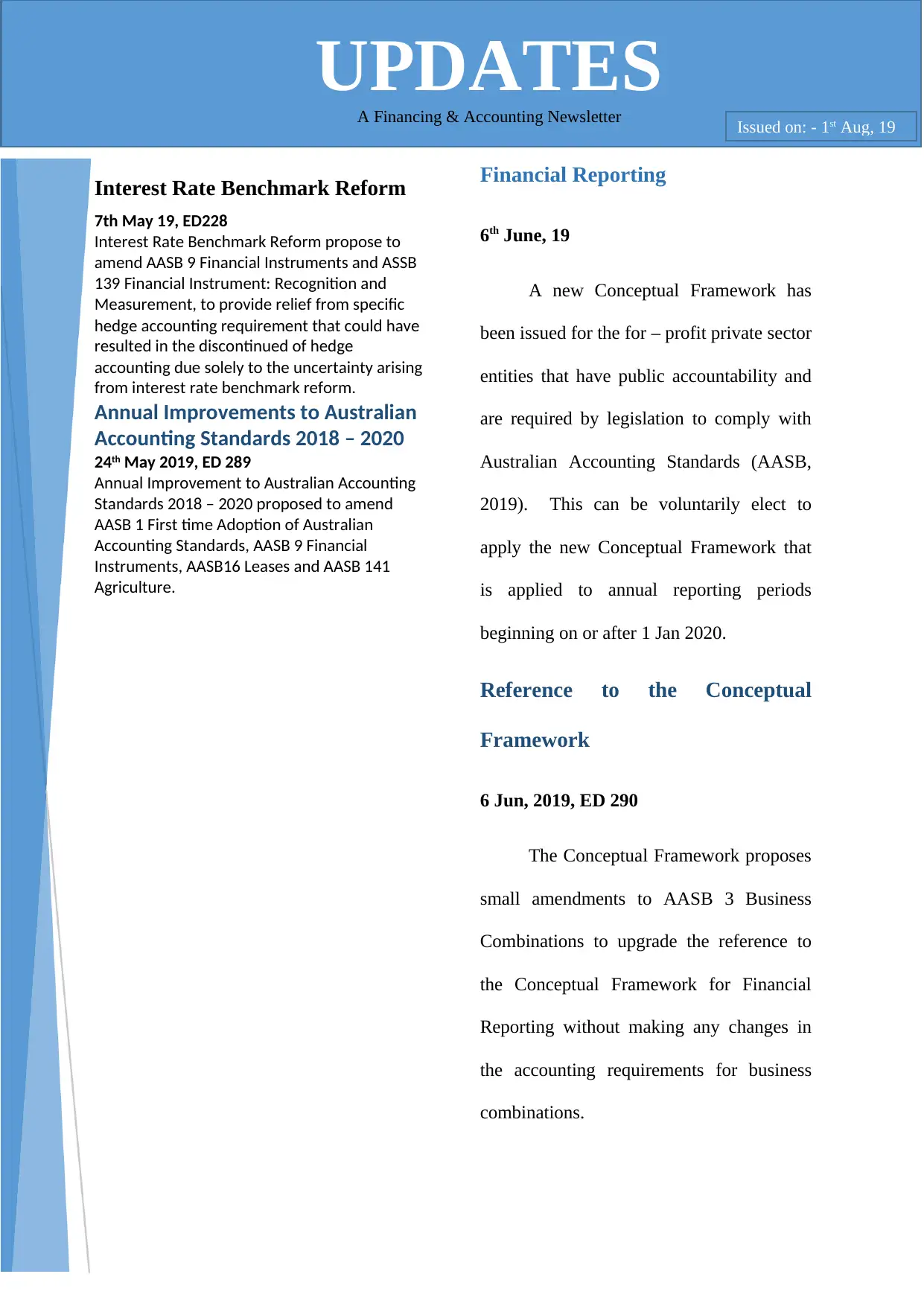
NN MC SJ MC BJ NC D DJN Conceptual Framework for
Financial Reporting
6th June, 19
A new Conceptual Framework has
been issued for the for – profit private sector
entities that have public accountability and
are required by legislation to comply with
Australian Accounting Standards (AASB,
2019). This can be voluntarily elect to
apply the new Conceptual Framework that
is applied to annual reporting periods
beginning on or after 1 Jan 2020.
Reference to the Conceptual
Framework
6 Jun, 2019, ED 290
The Conceptual Framework proposes
small amendments to AASB 3 Business
Combinations to upgrade the reference to
the Conceptual Framework for Financial
Reporting without making any changes in
the accounting requirements for business
combinations.
UPDATESA Financing & Accounting Newsletter Issued on: - 1st Aug, 19
Interest Rate Benchmark Reform
7th May 19, ED228
Interest Rate Benchmark Reform propose to
amend AASB 9 Financial Instruments and ASSB
139 Financial Instrument: Recognition and
Measurement, to provide relief from specific
hedge accounting requirement that could have
resulted in the discontinued of hedge
accounting due solely to the uncertainty arising
from interest rate benchmark reform.
Annual Improvements to Australian
Accounting Standards 2018 – 2020
24th May 2019, ED 289
Annual Improvement to Australian Accounting
Standards 2018 – 2020 proposed to amend
AASB 1 First time Adoption of Australian
Accounting Standards, AASB 9 Financial
Instruments, AASB16 Leases and AASB 141
Agriculture.
Financial Reporting
6th June, 19
A new Conceptual Framework has
been issued for the for – profit private sector
entities that have public accountability and
are required by legislation to comply with
Australian Accounting Standards (AASB,
2019). This can be voluntarily elect to
apply the new Conceptual Framework that
is applied to annual reporting periods
beginning on or after 1 Jan 2020.
Reference to the Conceptual
Framework
6 Jun, 2019, ED 290
The Conceptual Framework proposes
small amendments to AASB 3 Business
Combinations to upgrade the reference to
the Conceptual Framework for Financial
Reporting without making any changes in
the accounting requirements for business
combinations.
UPDATESA Financing & Accounting Newsletter Issued on: - 1st Aug, 19
Interest Rate Benchmark Reform
7th May 19, ED228
Interest Rate Benchmark Reform propose to
amend AASB 9 Financial Instruments and ASSB
139 Financial Instrument: Recognition and
Measurement, to provide relief from specific
hedge accounting requirement that could have
resulted in the discontinued of hedge
accounting due solely to the uncertainty arising
from interest rate benchmark reform.
Annual Improvements to Australian
Accounting Standards 2018 – 2020
24th May 2019, ED 289
Annual Improvement to Australian Accounting
Standards 2018 – 2020 proposed to amend
AASB 1 First time Adoption of Australian
Accounting Standards, AASB 9 Financial
Instruments, AASB16 Leases and AASB 141
Agriculture.
Paraphrase This Document
Need a fresh take? Get an instant paraphrase of this document with our AI Paraphraser
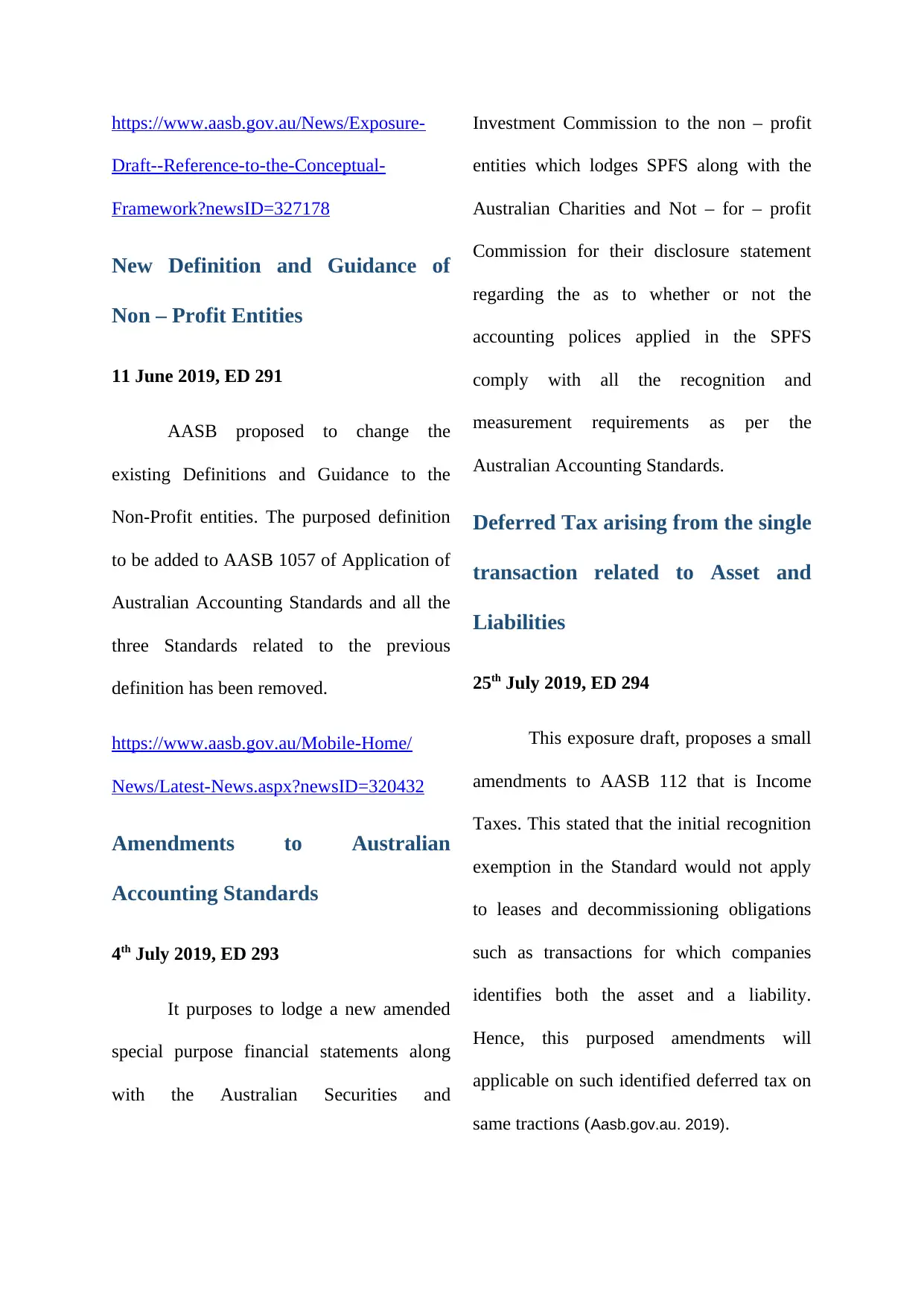
https://www.aasb.gov.au/News/Exposure-
Draft--Reference-to-the-Conceptual-
Framework?newsID=327178
New Definition and Guidance of
Non – Profit Entities
11 June 2019, ED 291
AASB proposed to change the
existing Definitions and Guidance to the
Non-Profit entities. The purposed definition
to be added to AASB 1057 of Application of
Australian Accounting Standards and all the
three Standards related to the previous
definition has been removed.
https://www.aasb.gov.au/Mobile-Home/
News/Latest-News.aspx?newsID=320432
Amendments to Australian
Accounting Standards
4th July 2019, ED 293
It purposes to lodge a new amended
special purpose financial statements along
with the Australian Securities and
Investment Commission to the non – profit
entities which lodges SPFS along with the
Australian Charities and Not – for – profit
Commission for their disclosure statement
regarding the as to whether or not the
accounting polices applied in the SPFS
comply with all the recognition and
measurement requirements as per the
Australian Accounting Standards.
Deferred Tax arising from the single
transaction related to Asset and
Liabilities
25th July 2019, ED 294
This exposure draft, proposes a small
amendments to AASB 112 that is Income
Taxes. This stated that the initial recognition
exemption in the Standard would not apply
to leases and decommissioning obligations
such as transactions for which companies
identifies both the asset and a liability.
Hence, this purposed amendments will
applicable on such identified deferred tax on
same tractions (Aasb.gov.au. 2019).
Draft--Reference-to-the-Conceptual-
Framework?newsID=327178
New Definition and Guidance of
Non – Profit Entities
11 June 2019, ED 291
AASB proposed to change the
existing Definitions and Guidance to the
Non-Profit entities. The purposed definition
to be added to AASB 1057 of Application of
Australian Accounting Standards and all the
three Standards related to the previous
definition has been removed.
https://www.aasb.gov.au/Mobile-Home/
News/Latest-News.aspx?newsID=320432
Amendments to Australian
Accounting Standards
4th July 2019, ED 293
It purposes to lodge a new amended
special purpose financial statements along
with the Australian Securities and
Investment Commission to the non – profit
entities which lodges SPFS along with the
Australian Charities and Not – for – profit
Commission for their disclosure statement
regarding the as to whether or not the
accounting polices applied in the SPFS
comply with all the recognition and
measurement requirements as per the
Australian Accounting Standards.
Deferred Tax arising from the single
transaction related to Asset and
Liabilities
25th July 2019, ED 294
This exposure draft, proposes a small
amendments to AASB 112 that is Income
Taxes. This stated that the initial recognition
exemption in the Standard would not apply
to leases and decommissioning obligations
such as transactions for which companies
identifies both the asset and a liability.
Hence, this purposed amendments will
applicable on such identified deferred tax on
same tractions (Aasb.gov.au. 2019).
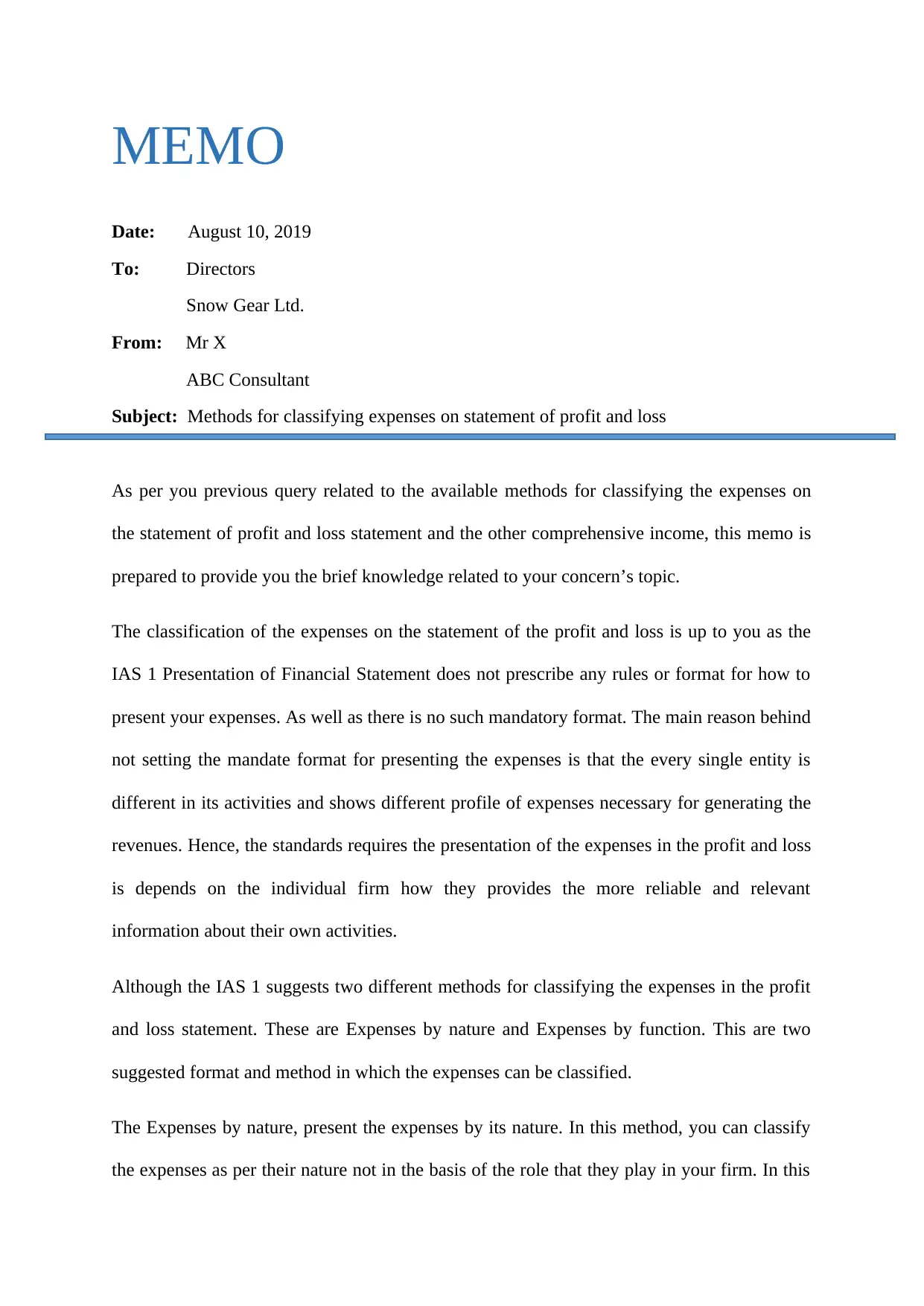
MEMO
Date: August 10, 2019
To: Directors
Snow Gear Ltd.
From: Mr X
ABC Consultant
Subject: Methods for classifying expenses on statement of profit and loss
As per you previous query related to the available methods for classifying the expenses on
the statement of profit and loss statement and the other comprehensive income, this memo is
prepared to provide you the brief knowledge related to your concern’s topic.
The classification of the expenses on the statement of the profit and loss is up to you as the
IAS 1 Presentation of Financial Statement does not prescribe any rules or format for how to
present your expenses. As well as there is no such mandatory format. The main reason behind
not setting the mandate format for presenting the expenses is that the every single entity is
different in its activities and shows different profile of expenses necessary for generating the
revenues. Hence, the standards requires the presentation of the expenses in the profit and loss
is depends on the individual firm how they provides the more reliable and relevant
information about their own activities.
Although the IAS 1 suggests two different methods for classifying the expenses in the profit
and loss statement. These are Expenses by nature and Expenses by function. This are two
suggested format and method in which the expenses can be classified.
The Expenses by nature, present the expenses by its nature. In this method, you can classify
the expenses as per their nature not in the basis of the role that they play in your firm. In this
Date: August 10, 2019
To: Directors
Snow Gear Ltd.
From: Mr X
ABC Consultant
Subject: Methods for classifying expenses on statement of profit and loss
As per you previous query related to the available methods for classifying the expenses on
the statement of profit and loss statement and the other comprehensive income, this memo is
prepared to provide you the brief knowledge related to your concern’s topic.
The classification of the expenses on the statement of the profit and loss is up to you as the
IAS 1 Presentation of Financial Statement does not prescribe any rules or format for how to
present your expenses. As well as there is no such mandatory format. The main reason behind
not setting the mandate format for presenting the expenses is that the every single entity is
different in its activities and shows different profile of expenses necessary for generating the
revenues. Hence, the standards requires the presentation of the expenses in the profit and loss
is depends on the individual firm how they provides the more reliable and relevant
information about their own activities.
Although the IAS 1 suggests two different methods for classifying the expenses in the profit
and loss statement. These are Expenses by nature and Expenses by function. This are two
suggested format and method in which the expenses can be classified.
The Expenses by nature, present the expenses by its nature. In this method, you can classify
the expenses as per their nature not in the basis of the role that they play in your firm. In this
⊘ This is a preview!⊘
Do you want full access?
Subscribe today to unlock all pages.

Trusted by 1+ million students worldwide
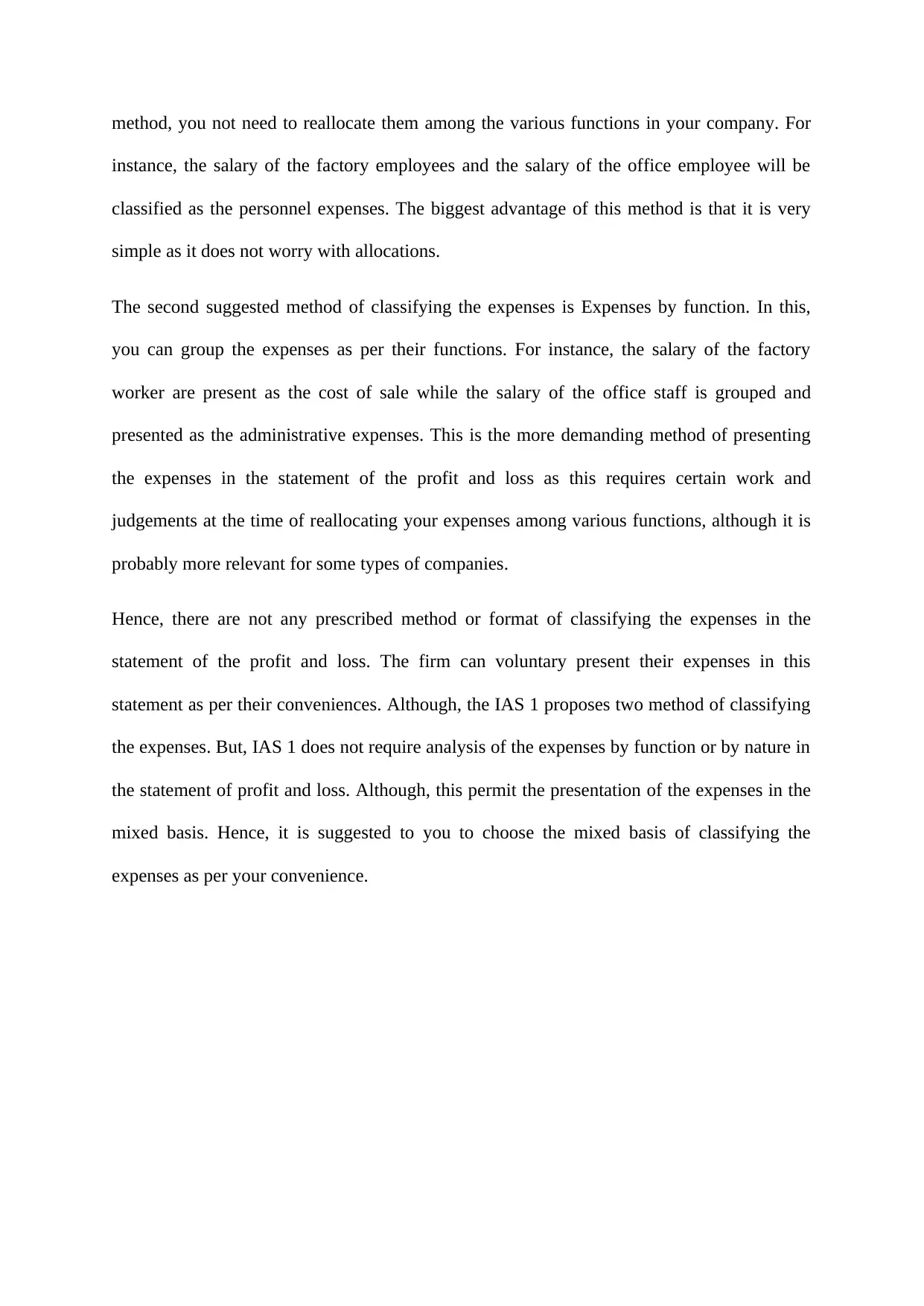
method, you not need to reallocate them among the various functions in your company. For
instance, the salary of the factory employees and the salary of the office employee will be
classified as the personnel expenses. The biggest advantage of this method is that it is very
simple as it does not worry with allocations.
The second suggested method of classifying the expenses is Expenses by function. In this,
you can group the expenses as per their functions. For instance, the salary of the factory
worker are present as the cost of sale while the salary of the office staff is grouped and
presented as the administrative expenses. This is the more demanding method of presenting
the expenses in the statement of the profit and loss as this requires certain work and
judgements at the time of reallocating your expenses among various functions, although it is
probably more relevant for some types of companies.
Hence, there are not any prescribed method or format of classifying the expenses in the
statement of the profit and loss. The firm can voluntary present their expenses in this
statement as per their conveniences. Although, the IAS 1 proposes two method of classifying
the expenses. But, IAS 1 does not require analysis of the expenses by function or by nature in
the statement of profit and loss. Although, this permit the presentation of the expenses in the
mixed basis. Hence, it is suggested to you to choose the mixed basis of classifying the
expenses as per your convenience.
instance, the salary of the factory employees and the salary of the office employee will be
classified as the personnel expenses. The biggest advantage of this method is that it is very
simple as it does not worry with allocations.
The second suggested method of classifying the expenses is Expenses by function. In this,
you can group the expenses as per their functions. For instance, the salary of the factory
worker are present as the cost of sale while the salary of the office staff is grouped and
presented as the administrative expenses. This is the more demanding method of presenting
the expenses in the statement of the profit and loss as this requires certain work and
judgements at the time of reallocating your expenses among various functions, although it is
probably more relevant for some types of companies.
Hence, there are not any prescribed method or format of classifying the expenses in the
statement of the profit and loss. The firm can voluntary present their expenses in this
statement as per their conveniences. Although, the IAS 1 proposes two method of classifying
the expenses. But, IAS 1 does not require analysis of the expenses by function or by nature in
the statement of profit and loss. Although, this permit the presentation of the expenses in the
mixed basis. Hence, it is suggested to you to choose the mixed basis of classifying the
expenses as per your convenience.
Paraphrase This Document
Need a fresh take? Get an instant paraphrase of this document with our AI Paraphraser
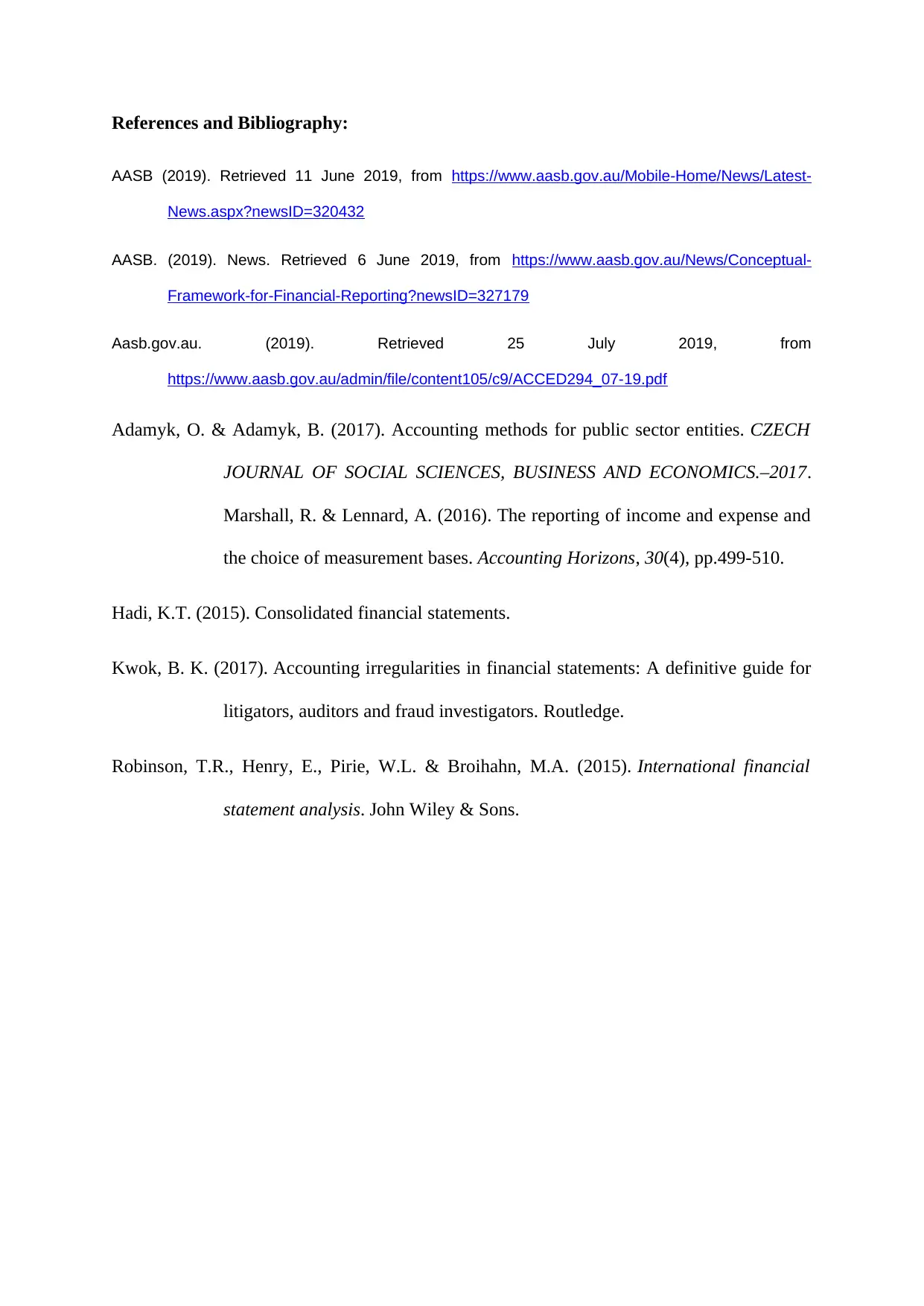
References and Bibliography:
AASB (2019). Retrieved 11 June 2019, from https://www.aasb.gov.au/Mobile-Home/News/Latest-
News.aspx?newsID=320432
AASB. (2019). News. Retrieved 6 June 2019, from https://www.aasb.gov.au/News/Conceptual-
Framework-for-Financial-Reporting?newsID=327179
Aasb.gov.au. (2019). Retrieved 25 July 2019, from
https://www.aasb.gov.au/admin/file/content105/c9/ACCED294_07-19.pdf
Adamyk, O. & Adamyk, B. (2017). Accounting methods for public sector entities. CZECH
JOURNAL OF SOCIAL SCIENCES, BUSINESS AND ECONOMICS.–2017.
Marshall, R. & Lennard, A. (2016). The reporting of income and expense and
the choice of measurement bases. Accounting Horizons, 30(4), pp.499-510.
Hadi, K.T. (2015). Consolidated financial statements.
Kwok, B. K. (2017). Accounting irregularities in financial statements: A definitive guide for
litigators, auditors and fraud investigators. Routledge.
Robinson, T.R., Henry, E., Pirie, W.L. & Broihahn, M.A. (2015). International financial
statement analysis. John Wiley & Sons.
AASB (2019). Retrieved 11 June 2019, from https://www.aasb.gov.au/Mobile-Home/News/Latest-
News.aspx?newsID=320432
AASB. (2019). News. Retrieved 6 June 2019, from https://www.aasb.gov.au/News/Conceptual-
Framework-for-Financial-Reporting?newsID=327179
Aasb.gov.au. (2019). Retrieved 25 July 2019, from
https://www.aasb.gov.au/admin/file/content105/c9/ACCED294_07-19.pdf
Adamyk, O. & Adamyk, B. (2017). Accounting methods for public sector entities. CZECH
JOURNAL OF SOCIAL SCIENCES, BUSINESS AND ECONOMICS.–2017.
Marshall, R. & Lennard, A. (2016). The reporting of income and expense and
the choice of measurement bases. Accounting Horizons, 30(4), pp.499-510.
Hadi, K.T. (2015). Consolidated financial statements.
Kwok, B. K. (2017). Accounting irregularities in financial statements: A definitive guide for
litigators, auditors and fraud investigators. Routledge.
Robinson, T.R., Henry, E., Pirie, W.L. & Broihahn, M.A. (2015). International financial
statement analysis. John Wiley & Sons.
1 out of 5
Related Documents
Your All-in-One AI-Powered Toolkit for Academic Success.
+13062052269
info@desklib.com
Available 24*7 on WhatsApp / Email
![[object Object]](/_next/static/media/star-bottom.7253800d.svg)
Unlock your academic potential
Copyright © 2020–2025 A2Z Services. All Rights Reserved. Developed and managed by ZUCOL.





